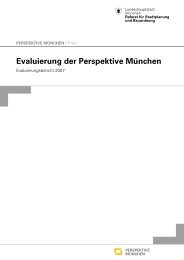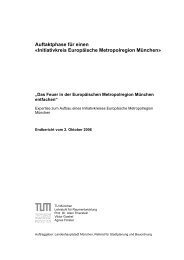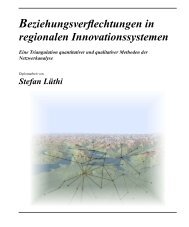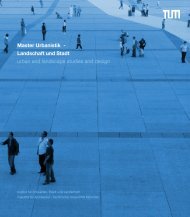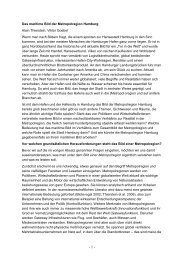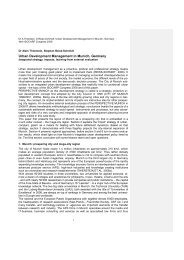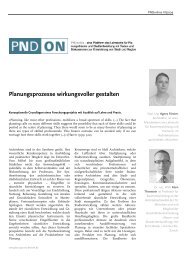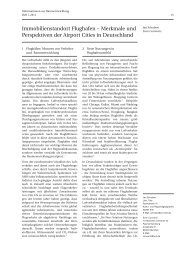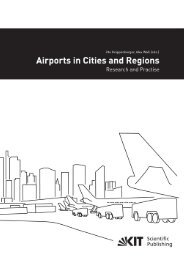0.6-1-Cover and Table of Contents-pp 0-05.indd - Raumentwicklung ...
0.6-1-Cover and Table of Contents-pp 0-05.indd - Raumentwicklung ...
0.6-1-Cover and Table of Contents-pp 0-05.indd - Raumentwicklung ...
You also want an ePaper? Increase the reach of your titles
YUMPU automatically turns print PDFs into web optimized ePapers that Google loves.
The Role <strong>of</strong> the Design Studio in Shaping an Architectural Education for Sustainable Development:<br />
The Case <strong>of</strong> Beirut Arab University<br />
KHALID S. AL-HAGLA<br />
affect attaining extensive underst<strong>and</strong>ing for<br />
sustainability. The first <strong>of</strong> these obstacles is the<br />
theoretical typology <strong>of</strong> the concept that needs a<br />
lot <strong>of</strong> elaboration to be physically embedded in<br />
design projects. Respondents note that “…there<br />
is a Lack <strong>of</strong> visual a<strong>pp</strong>lication for the theoretical<br />
ideas studied within lecture halls…. The courses<br />
we study about sustainability aren’t enough<br />
<strong>and</strong> their being theoretical without real testing<br />
<strong>and</strong> ways <strong>of</strong> using sustainable architecture in<br />
studio. They always talk to us about sustainability<br />
but they don’t show us some good examples<br />
that can help us” “We have reached a good<br />
underst<strong>and</strong>ing for sustainability techniques but<br />
not for sustainability design”. The last comment<br />
shows the need for more in-depth guidance<br />
that goes beyond the cliché embedding <strong>of</strong><br />
sustainability techniques in the design process.<br />
Another important obstacle is a<strong>pp</strong>arent from<br />
reading the respondents’ comments regarding<br />
the type <strong>of</strong> guidance they get in the design<br />
studio. This item, type <strong>of</strong> guidance, is correlated<br />
to a number <strong>of</strong> sub-items. The first <strong>of</strong> these is<br />
the difference between teaching staff in their<br />
evaluation <strong>and</strong> acceptance <strong>of</strong> sustainability<br />
concepts. These changing perspectives<br />
negatively affect the students’ educational<br />
outcomes. They note that “here whenever you<br />
talk or use any questionable ideas in our design,<br />
the doctors under estimate it, they are divided<br />
about the importance <strong>of</strong> sustainability itself…<br />
some pr<strong>of</strong>essors give a high importance for<br />
sustainable design <strong>and</strong> aspects while teaching<br />
assistances don’t give the same importance<br />
for the sustainability issues.” The second is the<br />
lack <strong>of</strong> coordination between different levels<br />
<strong>of</strong> design studios. This makes the knowledge <strong>of</strong><br />
sustainability not rooted in the design process.<br />
In this regard, fulfilling sustainability requirements<br />
is treated as a prerequisite to move to a higher<br />
level, which negatively affects the cumulative<br />
experience developed along the design<br />
studios.<br />
Evaluation comes as the final step in drawing<br />
a comprehensive vision <strong>of</strong> embedding<br />
sustainability underst<strong>and</strong>ings in studio-based<br />
architectural education. <strong>Table</strong> 3 shows the<br />
evaluation process as one <strong>of</strong> the weakest<br />
points among the aspects <strong>of</strong> design studio.<br />
However, part <strong>of</strong> these results is due to the<br />
usual disa<strong>pp</strong>ointment architectural students<br />
have after any evaluation process, but linking<br />
these numerical indicators to respondents’<br />
comments sheds more lights on the negligible<br />
role that evaluation plays in intensifying the<br />
underst<strong>and</strong>ing <strong>of</strong> sustainability. The problem<br />
could be addressed in two areas: the evaluation<br />
during the design process <strong>and</strong> the final<br />
evaluation - jury. The results (see table 3) show<br />
the high score that the fourth level respondents<br />
gave to the evaluation process compared with<br />
both the third <strong>and</strong> the fifth level respondents.<br />
In addition, all levels show a slight change in<br />
score between the regular evaluations <strong>and</strong> the<br />
final evaluation within the design studio, which<br />
reflects a consistent use <strong>of</strong> the same evaluation<br />
criteria. This is not the case when comparing<br />
the regular design studio evaluations to the<br />
jury discussion <strong>and</strong> evaluation (especially in<br />
the case <strong>of</strong> the score given by the fourth level<br />
respondents). The respondents’ comments come<br />
to cover both types <strong>of</strong> evaluation. They comment<br />
that “At the beginning, <strong>of</strong> any project we are<br />
guided to use sustainability underst<strong>and</strong>ings<br />
<strong>and</strong> concepts, but the evaluation come<br />
completely against these ideas this leads us to<br />
work not seriously <strong>and</strong> reflects to our non serious<br />
thinking about sustainability…. I don’t think that<br />
it is taken into consideration while evaluating<br />
Archnet-IJAR, International Journal <strong>of</strong> Architectural Research - Volume 6 - Issue 1 - March 2012<br />
37



